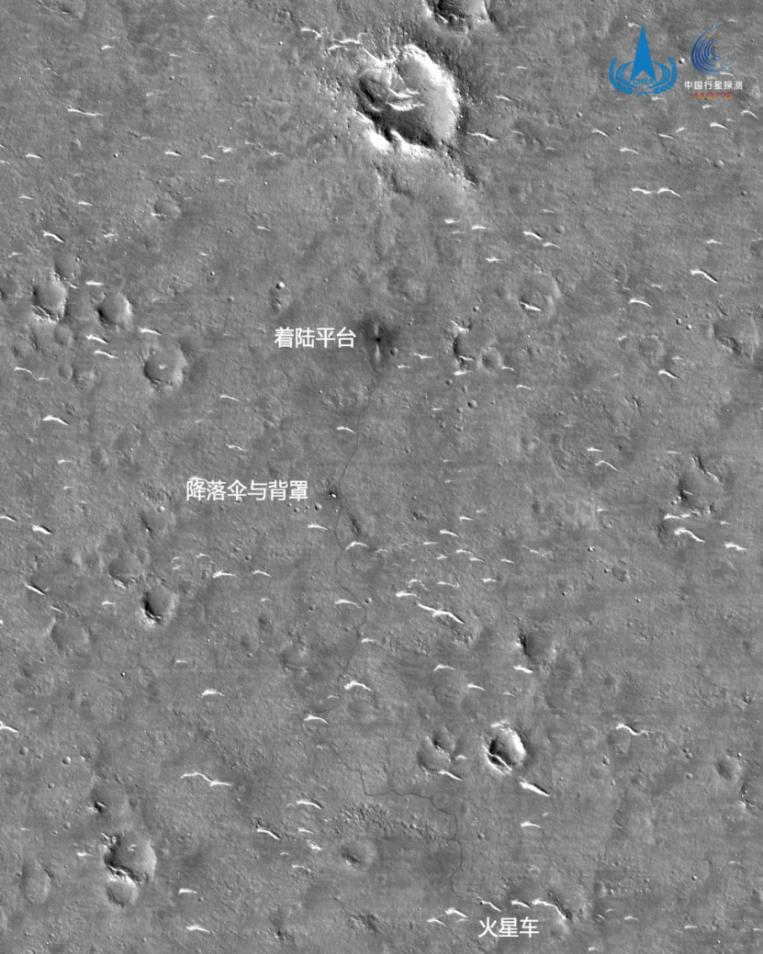A few days ago, the near-fire point of the "Tianwen-1" orbiter once again passed over the rover inspection area, and took a 0.5-meter resolution image of the "Zhurong" inspection area, and the driving route of the "Zhurong" rover in the picture was clearly recognizable.
As of March 24, 2022, the "Zhurong" rover has worked on the surface of Mars for 306 Martian days, with a total of 1784 meters, and the "Tianwen-1" orbiter has been in orbit for 609 days, 277 million kilometers away from the earth, and the current two are operating normally.

Figure 1
The high-resolution camera captures the image of the "Zhurong" inspection area
The "Zhu Rong" rover also transmitted selfies from the surface of Mars, compared with the photos taken when it just landed, it can be seen that the surface of the rover has accumulated a thin layer of sand dust. At the same time, judging by the telemetry information of the Mars rover, the power generation efficiency of the solar wing has been affected to a certain extent, but the energy is still sufficient. In order to cope with the dust cover, the rover solar wing has been specially designed to take a variety of measures to deal with the decline in power generation efficiency caused by sand and dust, which is not currently needed, and the current energy state is enough to support the rover to continue to drive and carry out exploration.
(a) Photographed on May 19, 2021 (5th Mars Day after landing), the surface of the rover is free of dust and sand.
(b) Photographed on January 22, 2022 (247th Martian Day after landing), there is a significant dust cover on the surface of the rover.
Figure 2
Navigation terrain cameras take images of the rover body at different times
Martian dust storms will directly affect the energy acquisition of Mars rovers and have been attracting much attention. The engineering team continued to monitor Martian dust weather through images obtained by the medium resolution camera of the Tianwen-1 orbiter, and found that since late January this year, there has been a significant aeolian sand activity in the area north of 60° north latitude of Mars. As can be seen from the figure below, there was a local sandstorm in this area in February this year, and the typical features were covered with a large amount of sand and dust, which was difficult to distinguish.
(a) Taken on January 22, 2022 The center of the image (30.7° east longitude, 74.0 degree north latitude).
(b) Taken on 10 February 2022 The center of the image (37.8° east longitude, 72.9° north latitude) occurred in a local sandstorm and the features were difficult to distinguish.
Figure 3
Medium-resolution cameras capture a comparison of aeolian sand activity at high latitudes in the Northern Hemisphere
At present, the northern hemisphere of Mars has begun to enter autumn. According to the analysis of previous exploration data, autumn is the season of frequent martian dust weather, but at present, no obvious sand and dust weather has been observed in the "Zhurong" inspection area.
(a) Taken on March 24, 2021, center of the image (110.2°E, 24.6°N).
(b) Taken on 30 January 2022, center of the image (107.4° E, 24.4° N).
Figure 4
Resolution imagery in the landing patrol area of the "Zhu Rong"
The Tianwen-1 orbiter continues to carry out global remote sensing exploration of Mars, focusing on typical geomorphological and geological units such as craters, volcanoes, canyons, and dry riverbeds, and obtaining high-resolution images of them. On March 7 this year, the U.S. Perseverance rover was photographed while imaging jezero impact crater, which is currently located about 200 meters southeast of its landing site.
Figure 5
The American "Perseverance" rover photographed by "Tianwen-1"
Source: China Lunar Exploration Project; Cartography: National Astronomical Observatory
Editor: Zhang Shuang
Review: Julie
Final Judgement: Wang Yu